Dr. Stephanie Wood, PhD Equine Nutrition, PgDip,
BSc (Hons), RNutr (Animal), R.Anim.Tech
The use of plants for medicinal purposes stretches back since records began, predominantly focusing on human health, but over recent years there has been growing interest in how certain plants can support animal health. One such plant is Boswellia, which is now extremely popular with horse owners and is available on its own and incorporated into formulated products. This popular ingredient triggers extensive debate amongst owners, primarily focusing on the level of boswellic acids. This debate is valid since boswellic acids are the components of the plant that have been shown to have health benefitting properties (Ammon, 2010; Daly et al., 2011; Roy et al., 2019; Al-Harrasi et al., 2021), however it is not the only consideration. Here at Feedmark we openly acknowledge that the research to date has not provided a minimum boswellic acid requirement for humans or animals, or a recommended boswellic acid level, and therefore we should not focus solely on the level of boswellic acids in products. Boswellic acid profile, feeding level and feeding form are important factors that also need to be considered when wanting our horses to benefit from Boswellia.
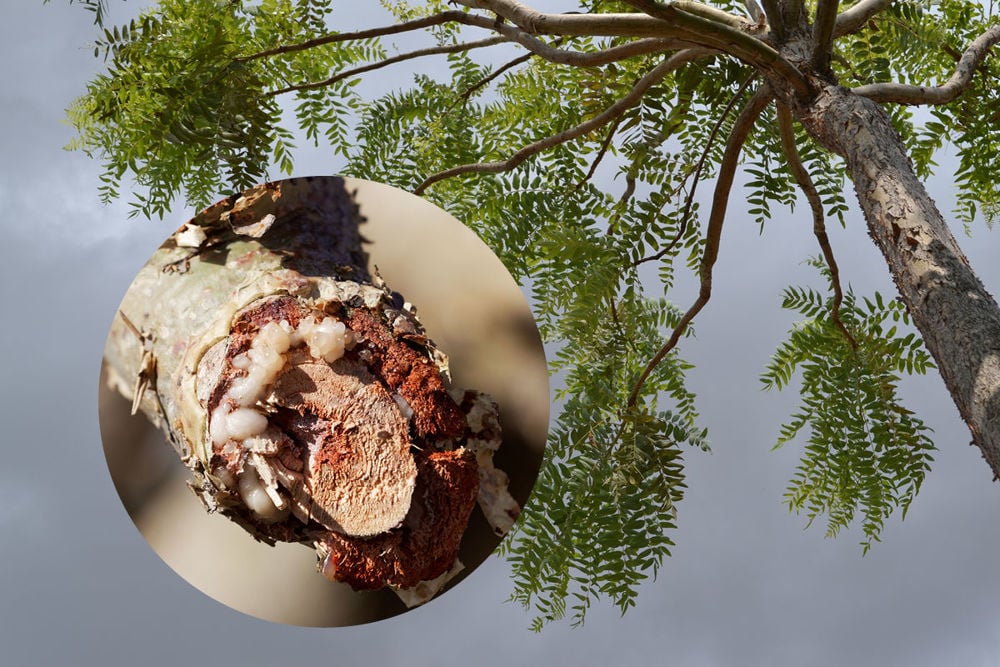
Figure 1. Boswellia serrata tree that produces resin (insert) within its trunk and branches which is harvested for its anti-inflammatory properties
BOSWELLIA THE BOTANIC
Boswellia is one genus within the Burseraceae family of plants. Within the Boswellia genus there are 28 species names currently accepted (WFO, 2021), although there are names that are synonymous with accepted names, which can lead to confusion on what species are available or included in products (Table 1). Boswellia species are native to tropical America, Africa and Asia, with specific species grown in specific locations (Daly et al., 2011; Iram et al., 2017).
Table 1. Organisation of key Boswellia species
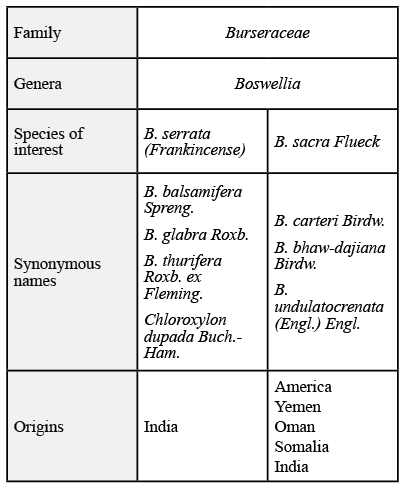
The reference to Boswellia serrata that is commonly cited in equine information and product pages relates to a specific Boswellia species found in India, and which can be correctly referred to as Indian Frankincense (Figure 1). However, the terms Boswellia serrata and Indian Frankincense are often mistakenly used as a generic term for all Boswellia species, most likely due to Boswellia serrata being the most abundant of Boswellia species and the one that seems to be harvested the most for its resin, and not because it is superior compared to other Boswellia species. Boswellia sacra, also known as Boswellia carteri, is a lesser known Boswellia species that has been shown to contain high levels of boswellic acids and have the same medicinal properties as the more well-known Boswellia serrata (Daly et al., 2011; Mannino et al., 2016).
Plants in the Boswellia genus are generally in the form of trees and shrubs which have canals within their trunk and branch structures. Within these canals is resin, also referred to as oleo-gum resin, or simply gum-resin (Daly et al., 2011). The resin is harvested from the Boswellia trees by either slicing or boring into the bark, then dried and processed for use in products. The species from which the resin originates influences its composition and appearance, which can range from clear to milky in colour and from watery to gum-like in consistency (Daly et al., 2011). Reports on the composition of Boswellia resins vary, with the lipophilic parts (fat-loving compounds that dissolve or combine well with fat) of the resin being the most important as these are rich in terpenoids (Al-Harrasi et al., 2018). Al-Harrasi et al. (2018) report that resin from Boswellia carteri grown in Oman and in its natural state, contained 55-65% lipophilic compounds, whilst Mannino et al. (2016) found total lipophilic compounds averaged 55% in Boswellia serrata and 60% in Boswellia carteri.
So you may be wondering what terpenoids are and why they are important. They are important because boswellic acids comprise of terpenoids, specifically pentacyclic triterpene molecules, and boswellic acids have been shown to have medicinally important qualities and so can be thought of as the active part of triterpenes within Boswellia resin. However, the lipophilic part of Boswellia resin is not all boswellic acids as it contains other terpenes such as mono-, di- and other triterpenes, not just the pentacyclic forms found in boswellic acids. Therefore, any products reporting just the lipophilic component of Boswellia resin will be overestimating boswellic acid levels.
BOSWELLIC ACIDS
As already highlighted, medicinal properties have been attributed to boswellic acids, however research has shown that certain boswellic acids have greater effect than others (Roy et al., 2019), hence the need to consider the boswellic acid profile. Research has identified multiple types of boswellic acids in Boswellia resins, with up to 12 acids being identified within the resin of Boswellia serrata and Boswellia carteri species (Al-Harrasi et al., 2018; Roy et al., 2019). Six of these boswellic acids have been identified as the main acids associated with inhibiting the enzymes involved in inflammation, although the different acids vary in their contribution to the total boswellic acid content (Table 2).
Table 2. Contribution of boswellic acids to the total boswellic acid content in resin from Boswellia serrata and Boswellia carteri associated with inhibiting inflammation
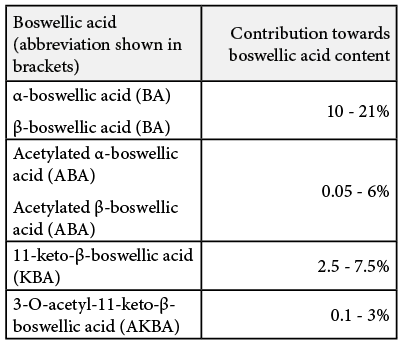
In vitro (laboratory based) research indicates that KBA and AKBA are the most potent and effective boswellic acids at down-regulating inflammatory enzymes, thought to be due to the presence of the 11-keto group (Roy et al., 2019). However, some studies indicate that boswellic acids are relatively poorly absorbed and metabolised by the body. The potential limited absorption of boswellic acids is something that is not acknowledged or discussed, yet it is paramount, as having high levels of boswellic acids in a product means very little if those acids are not absorbed by the animal. In vitro studies into the ability of boswellic acids to cross a simulated intestinal wall are inconclusive, with some studies finding low permeability for AKBA, and moderate permeability for a Boswellia serrata extract (Krϋger et al., 2009), whilst another in vitro study found both KBA and AKBA were very permeable (Gerbeth et al., 2013). The variability in these results shows more research is required to determine the ability of boswellic acids to cross the intestinal wall, and raises the question; can boswellic acid absorption be increased in any way?
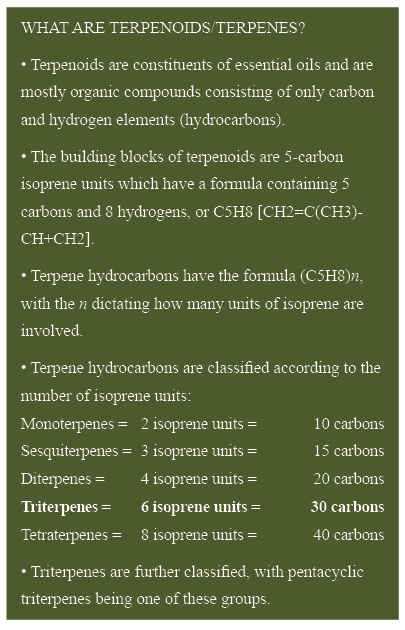
The lipophilic nature of boswellic acids limits their solubility in water but increases their ability to combine with fats, therefore it was hypothesised that feeding the acids alongside fat could increase their absorption. Research in humans indicates that administering boswellic acids orally with a meal containing fat increases absorption of the acids, based on a greater increase in plasma boswellic acid levels after consumption with a fat-based meal compared to consumption of the acids alone (Sterk et al., 2004). Such findings offer potential for increasing boswellic acid absorption in horses as the feeding of fat in the equine diet is relatively common and is easily achieved. Piperine, a compound found in Black Pepper (Piper nigrum L.) and Long Pepper (Piper longum L.), has been shown to improve boswellic acid absorption in rabbits, and so offers another potential method of increasing boswellic acid utilisation (Vijayarani et al., 2020), although further research is needed to determine the true picture of boswellic acid absorption in horses. Until such research takes place, we should focus on using the most effective sources of boswellic acids and feeding appropriate amounts.
PHYSIOLOGICAL ACTIONS OF BOSWELLIC ACID
Despite the lack of research to demonstrate the beneficial effects of Boswellia in horses, there is a demand for Boswellia equine products, indicating that owners are seeing benefits to feeding this herb. These benefits are mainly due to the anti-inflammatory and immune-supporting actions of Boswellia which have been demonstrated in laboratory studies, human trials (Sengupta et al., 2008) and in dogs (Reichling et al., 2004). General literature states that boswellic acids can modulate enzymes involved in the inflammatory process, namely growth factors, kinases, and transcription factors (Ammon, 2010; Roy et al., 2019). Literature also promotes that boswellic acids can stimulate apoptosis (cell death), which has focused research in humans on the anti-cancer effects of Boswellia. Cancers are relatively rare in equids compared to other conditions therefore Boswellia is not fed for this reason, however the anti-inflammatory properties of Boswellia make it an attractive ingredient for supporting joint function (Figure 2).
Joint issues and mobility support
Osteoarthritis is the most common joint issue affecting humans, horses and dogs (Carmona & Prades, 2009). The condition is characterised by progressive cartilage deterioration, subchondral bone remodelling (changes to the bone under the cartilage), loss of joint space, development of bony projections or spurs (osteophytosis) and pain, leading to reduced function and mobility (Schlueter & Orth, 2004). Regardless of the cause of osteoarthritis, the condition is associated with inflammation caused by proinflammatory substances which induce degradation of cartilage and the physiological changes described previously.
At the molecular level, osteoarthritis results from an imbalance of substances that promote synthesis of the extracellular matrix (ECM) of articular cartilage, and substances that induce remodelling of these components (Table 3) (Schlueter & Orth, 2004; Carmona & Prades, 2009). To counteract normal degradation (catabolism) of tissue, the body also produces anabolic molecules which function to counteract this degradation and promote growth or repair of tissues. Anabolic molecules are produced to counteract the catabolic effects of joint wear and osteoarthritis however the effects of the catabolic molecules tend to dominate (Schlueter & Orth, 2004; Carmona & Prades, 2009).
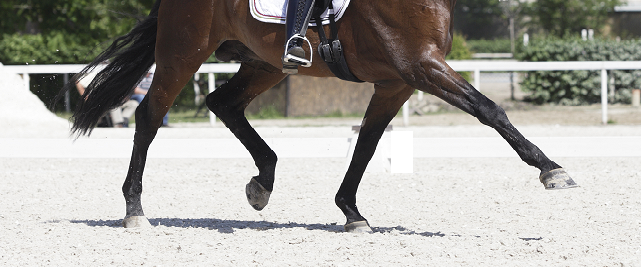
Figure 2. The anti-inflammatory properties of boswellic acids are beneficial for supporting mobility and joint function
Research into the effects of Boswellic acids on inflammation associated with osteoarthritis has shown that they can inhibit and stimulate various molecules. Several of these studies are highlighted below:
- Extracts of specific boswellic acids, AKBA and acetyl α-boswellic acid, inhibited the generation of proinflammatory TNFα in vitro, with AKBA being the most active component (Syrovets et al., 2005).
- Boswellia extract containing 30% AKBA (5-Loxin®) prevented TNFα induced expression of MMPs in vitro using human cells (Roy et al., 2005). The same extract has also been shown to reduce knee pain and improve function within seven days in humans suffering from osteoarthritis who were administered a daily oral dose of 100mg and 250mg (Sengupta et al., 2008) when used in a double-blind, randomised placebo-controlled trial.
- Boswellia extracts and boswellic acids inhibit the synthesis of leukotrienes which are key pro-inflammatory molecules, with the presence of the 11-keto group thought to be a requirement for this inhibitory action (Roy et al., 2019), explaining the greater effects seen with KBA and AKBA. This inhibitory action is due to boswellic acids inhibiting 5-lipoxygenase (5-LOX), the key enzyme in leukotriene synthesis (Siemoneit et al., 2009). However, these results were gained in vitro along with results that indicated that albumin cancels out this inhibitory effect, as albumin binds to 11-keto-boswellic acids. Albumin is a key component of blood therefore boswellic acids may not be effective in reducing leukotriene synthesis due to being bound to albumin once absorbed. Further research is required to confirm such findings.
- A study feeding a Boswellia serrata extract containing >50% triterpenes (actual boswellic acid levels not disclosed) at a dose of 400mg extract/10kg body weight, to 29 dogs with inflammatory joint and spinal disease, found that clinical signs greatly improved over a 6-week period (Reichling et al., 2004). No pharmacological tests were performed so there was no data on absorption or possible modes of action, however clinical assessment of lameness and movement by a veterinary professional indicated much improvement in the dogs.
Table 3. Key molecules involved in osteoarthritis in equids
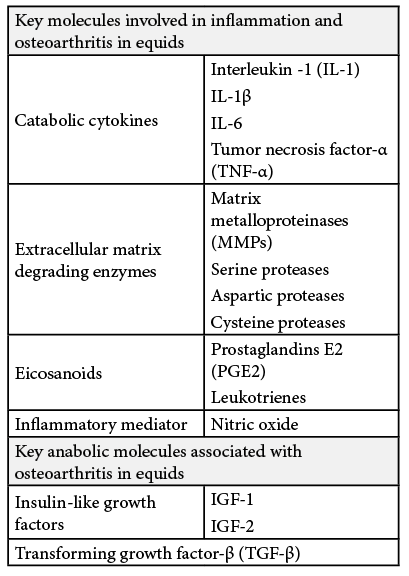
Gastric, respiratory and immune support
Boswellic acids have been shown to increase antibody production when administered at low doses (25mg/kg BW) to mice, giving them an immunostimulatory action at low doses (Ammon, 2010). However, when given at higher doses (50-200mg/kg BW) this effect is thought to be reversed, having an immune-depressing action (Ammon, 2010; Roy et al., 2019). Such effects could be deleterious depending on the situation, for example conditions caused by over activity of the immune system could be perpetuated if low doses of boswellic acids are given, whereas feeding a similarly low dose to rundown horses could stimulate immunity with beneficial effects. For these reasons it is important to discuss your horse’s requirements, and the potential for Boswellia to support your horse, with your vet if they have immune related issues.
Boswellic acids are also promoted for their gastroprotective and calming properties and are proposed as support for inflammatory bowel disease and diarrhoea (Ammon, 2010; Roy et al., 2019). Studies in rats show that boswellic acids have an antispasmodic action which calms the digestive tract, reduces motility leading to a slowing of digesta passage and reduced diarrhoea (Borrelli et al., 2006). In addition, boswellic acids are thought to protect against gastric ulcers in rats due to their inhibitory effect on 5-LOX, thus inhibiting the synthesis of pro-inflammatory leukotrienes (Ammon, 2010). This link has not been established in horses but certainly warrants further investigation due to the prevalence of gastric ulcers in horses, particularly performance horses.
The inhibitory effect of boswellic acids on leukotrienes is also associated with the respiratory supporting qualities of Boswellia (Ammon, 2010). Leukotrienes are known to induce bronchoconstriction and mucus secretion (Ammon, 2010) which reduce respiratory efficiency and make breathing even harder for those with sensitivities to certain particles such as dust or pollens. Scientific studies to support the use of Boswellia for respiratory health in animals are lacking however the lack of studies indicating any negatives of giving respiratory sensitive animals Boswellia indicates it is safe to feed for such issues.
SUMMARY
Boswellia is a herb with many qualities that are beneficial to our horses, with its anti-inflammatory action offering the most potential for a range of issues. This review has highlighted that the boswellic acid profile, boswellic acid level and mode of feeding should all be considered, with the feeding of fat and Piperine offering potential to increase absorption. The feeding of Boswellia extracts is one option for providing the important boswellic acids, however there is no recommended minimum boswellic acid level. Feeding 20g of a dried boswellia resin which contains 35% boswellic acids provides more boswellic acids than feeding 10g of a boswellia extract containing 65% boswellic acids, and unless stated the boswellic acid profile is unlikely to be known. Use of products that have a high percentage of total boswellic acids and specifically AKBA, the most potent inflammatory inhibiting boswellic acid, will provide excellent support to your horses, although such concentrated boswellic acids are more costly, meaning the decision as to which form of boswellia you feed has another factor to consider.
There is criticism about the lack of supporting research for herbal supplements, however we believe owners know their horses the best and can make informed decisions on what works for their horses. Boswellia resin and Boswellia extracts do have research supporting their actions, although we would always like studies conducted on horses.
REFERENCES
Al-Harrasi, A., Khan, A.L., Rehman, N.U., & Csuk, R. (2021). Biosynthetic diversity in triterpene cyclization within the Boswellia genus. Phytochemistry, 184: 112660. doi.org/10.1016/j.phytochem.2021.112660
Al-Harrasi, A., Rehman, N.U., Khan, A.L., Al-Broumi, M., Al-Amri, I., Hussain, J., Hussain, H., & Csuk, R. (2018). Chemical, molecular and structural studies of Boswellia species: β-Boswellic Aldehyde and 3-epi-11β-Dihydroxy BA as precursors in biosynthesis of boswellic acids. PLoS ONE, 13(6): e0198666. doi.org/10.1371/journal.pone.0198666
Ammon, H.P.T. (2010). Modulation of the immune system by Boswellia serrata extracts and boswellic acids. Phytomedicine, 17: 862-867. doi:10.1016/j.phymed.2010.03.003
Borrelli, F., Capasso, F., Capasso, R., Ascione, V., Aviello, G., Longo, R., & Izzo, A.A. (2006). Effect of Boswellia serrata on intestinal motility in rodents: inhibition of diarrhoea without constipation. British Journal of Pharmacology, 148(4): 553-560. doi:10.1038/sj.bjp.0706740
Carmona, J., & Prades, M. (2009). Pathophysiology of Osteoarthritis. Compendium Equine, January/February: 28-39.
Daly, D.C., Harley, M.M., Martínez-Habibe, M.-C., & Weeks, A. (2011). Burseraceae. In: Kubitzki, K. (ed) The Families and Genera of Vascular Plants ,Volume X Flowering Plant Eudicots. Springer, Berlin, Germany.
Gerbeth, K., Hϋsch, J., Fricker, G., Werz, O., Schubert-Zsilavecz, M., & Abdel-Tawab, M. (2013). In vitro metabolism, permeation, and brain availability of six major boswellic acids from Boswellia serrata gum resins. Fitoterapia, 84: 99-106. doi.org/10.1016/j.fitote.2012.10.009
Iram, F., Khan, S.A., & Husain, A. (2017). Phytochemistry and potential therapeutic actions of Boswellic acids: A mini-review. Asian Pacific Journal of Tropical Biomedicine, 7(6): 513-523. doi.org/10.1016/j.apjtb.2017.05.001
Krüger, P., Kanzer, J., Hummel, J., Fricker, G., Schubert-Zsilavecz, M., & Abdel-Tawab, M. (2006). Permeation of Boswellia extract in the Caco-2 model and possible interactions of its constituents KBA and AKBA with OATP1B3 and MRP2. European Journal of Pharmaceutical Sciences, 36(2-3): 275-284. doi:10.1016/j.ejps.2008.10.005
Mannino, G., Occhipinti, A., & Maffei, M.E. (2016). Quantitative Determination of 3-O-Acetyl-11-Keto--Boswellic Acid (AKBA) and Other Boswellic Acids in Boswellia sacra Flueck (syn. B. carteri Birdw) and Boswellia serrata Roxb. Molecules, 21(10): 1329. doi.org/10.3390/molecules21101329
Reichling, J., Schmökel, H., Fitzi, J., Bucher, S., & Saller, R. (2004). Dietary support with Boswellia resin in canine inflammatory joint and spinal disease. Schweiz Arch Tierheilkd, 146(2): 71-79. doi: 10.1024/0036-7281.146.2.71
Roy, N,K., Parama, D., Banik, K., Bordoloi, D., Devi, A.K., Thakur, K.K., Padmavathi, G., Shakibaei, M., Fan, L., Sethi, G., Kunnumakkara, A.B. (2019). An Update on Pharmacological Potential of Boswellic Acids against Chronic Diseases. International Journal of Molecular Science, 20 (17): 4101. doi.org/10.3390/ijms20174101
Roy, S., Khanna, S., Shah, H., Rink, C., Phillips, C., Preuss, H., Subbaraju, V.G., Trimurtulu, G., Krishnaraju, A.V., Bagchi, M., Bagchi, D., & Sen, C.K. (2005). Human Genome Screen to Identify the Genetic Basis of the Anti-inflammatory Effects of Boswellia in Microvascular Endothelial Cells. DNA and Cell Biology, 24(4): 244-255.
Schlueter, A.E., & Orth, M.W. (2004). Equine osteoarthritis: a brief review of the disease and its causes. Equine and Comparative Exercise Physiology, 1(4): 221-231. doi:10.1079/ECEP200428
Sengupta, K., Alluri, K.V., Satish, A.R., Mishra, S., Golakoti, T., Sarma, K.V.S., Dey, D., & Raychaudhuri, S.P. (2008). A double blind, randomized, placebo controlled study of the efficacy and safety of 5-Loxin® for treatment of osteoarthritis of the knee. Arthritis Research & Therapy, 10(4): R85. doi.org/10.1186/ar2461
Siemoneit, U., Pergola, C., Jazzar, B., Northoff, H., Skarke, C., Jauch, J., & Werz, O. (2009). On the interference of boswellic acids with 5-lipoxygenase: Mechanistic studies in vitro and pharmacological relevance. European Journal of Pharmacology, 606: 246-254. doi:10.1016/j.ejphar.2009.01.044
Sterk, V., Büchele, B., & Simmet, T. (2004). Effect of food intake on the bioavailability of boswellic acids from a herbal preparation in healthy volunteers. Planta Med, 70(12): 1155-1160. doi: 10.1055/s-2004-835844
Syrovets, T., Büchele, B., Krauss, C., Laumonnier, Y., & Simmet, T. (2005). Acetyl-Boswellic Acids Inhibit Lipopolysaccharide-Mediated TNF-α Induction in Monocytes by Direct Interaction with IκB Kinases. The Journal of Immunology, 174(1): 498-506. doi.org/10.4049/jimmunol.174.1.498
Vijayarani, K.R., Govindarajulu, M., Ramesh, S., Alturki, M., Majrashi, M., Fujihashi, A., Almaghrabi, M., Kirubakaran, N., Ren, J., Babu, R.J., Smith, F., Moore, T., & Dhanasekaran, M. (2020). Enhanced Bioavailability of Boswellic Acid by Piper longum: A Computational and Pharmacokinetic Study. Frontiers in Pharmacology, 11: 551911. doi:10.3389/fphar.2020.551911
WFO (2021). World Flora Online: Boswellia. Published on the Internet; http://www.worldfloraonline.org. Accessed 29 March 2021.

